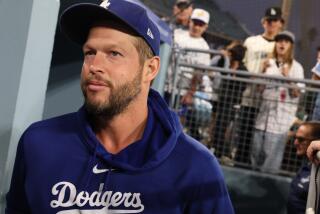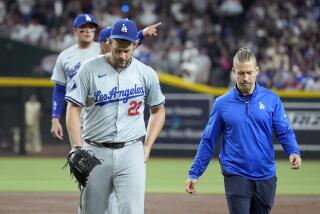Health Is the First Order of Business : Baseball: Many teams are relying on marquee players to rebound from injuries.
- Share via
Among the myriad negative aspects in baseball’s dreadful 1992 season was the amazing inability of most players to stay healthy.
During the ’92 season, the disabled list was used a record 351 times. So many players were going down that it seemed MRIs became more important than RBIs.
Because there were so many injuries and so many of them were suffered by major players, how well all those people come back will greatly influence the fortunes of many clubs in 1993.
No matter how players appear to be progressing in offseason workouts, their status will remain uncertain until they start playing regularly in spring training. And because of all those ifs, many teams already have had to make contingency moves in case their damaged stars don’t bounce back.
The Dodgers are a prime example. Darryl Strawberry missed all but 43 games last season because of a herniated disk that required surgery in September; Eric Davis played in 76 games before being forced out with wrist and shoulder injuries.
The prognosis for each seems hopeful. Davis has had no problems while participating in offseason Dodgers workouts and is expected to be full speed for the opening of spring training. Strawberry started swinging a bat last week for the first time since his surgery and says he feels fine. “I’ve had to be patient about the rehabilitation, but I’ve been determined,” he says. “After suffering the loss of a season, the determination to come back was strong.”
Although Strawberry is hoping to be ready for opening day, the Dodgers are cautious. Some club officials privately think he won’t be ready to go full speed until May. The uncertainty with Strawberry and Davis is largely why Los Angeles signed free agent Cory Snyder. The Dodgers were left without much outfield production after Strawberry and Davis went down last year. Snyder should provide a decent alternative.
Strawberry is far from being the only megastar plotting a comeback. There’s no bigger name in sports than Bo Jackson, though he has been virtually inactive for two seasons after requiring hip replacement surgery. Jackson has made remarkable progress to the point where he worked out in front of media for the first time two weeks ago. “The hip feels like I haven’t had any problems in the past, and I’m in great shape,” Jackson says.
However, neither Jackson nor Chicago White Sox management will get overly excited until he starts doing baseball-related activity every day in spring training. Says General manager Ron Schueler, “I have to prepare this club without Bo.”
As big a boost as Jackson’s return might provide to Chicago, of more immediate importance is the status of shortstop Ozzie Guillen, who was sidelined for the season after suffering torn knee ligaments in an outfield collision on April 22.
Guillen’s progress is to the point where he thinks he will be 100% by spring training. “I couldn’t even straighten out my knee a couple of months ago,” he says. “Now, I’m able to do everything. I’m feeling a lot better, and I have no doubt I’ll be full strength for spring training.”
Because of Guillen’s questionable status, the White Sox couldn’t listen to offseason inquiries regarding infielder Craig Grebeck. And Chicago was also forced to protect Grebeck in the expansion draft as a hedge against Guillen not being ready.
Meanwhile, the Chicago Cubs say Shawon Dunston is ready to go full speed after missing most of last season because of a herniated disk. Dunston is more cautious, saying, “This is a serious injury, and I can’t start setting a lot of goals other than to try to be ready for opening day.”
If Dunston proves to be fully recovered during spring training, look for the Cubs to shop his services. Chicago has Rey Sanchez and Jose Vizcaino available to play short. Chicago tried to swing deals for Dunston over the winter, but his physical status made other clubs back off. Teams that have had some interest in Dunston include the Toronto Blue Jays, Philadelphia Phillies, Houston Astros, Minnesota Twins and Boston Red Sox.
Perhaps of equal importance to the Cubs is the status of pitcher Mike Harkey. He is trying to recover from a ruptured knee tendon, an injury incurred when Harkey mindlessly tried a cartwheel before a game. Harkey is not expected to be more than 80% by spring training with his availability questionable for the opening of the season.
If Harkey can’t be part of the Cubs’ rotation, they would have to scramble for a fifth starter. It could be youngsters Lance Dickson or Turk Wendell, both of whom are trying to come back from arm injuries. It could be Shawn Boskie or Dan Plesac, or the Cubs might use one of their several left-handed pitchers as trade bait for a serviceable starting pitcher.
Few pitchers will be watched more closely this spring than Milwaukee’s Ted Higuera, who has been basically inactive for two seasons because of a torn rotator cuff. The Brewers have a big gap in their rotation created by the free-agent exit of Chris Bosio. “If Teddy is ever going to come back, it’s going to be this year because all our reports on him indicate that he’s healthy,” Brewers General manager Sal Bando says. “So we’re assuming he’s coming to camp and being a candidate for the rotation. But until we see him pitch, we’re just not going to know.”
If Higuera can’t come back, the Brewers would likely try to rush young Mark Kiefer into the rotation and hope he is the second coming of Cal Eldred, who joined the team at midseason and won 11 of 13 games, including 10 in a row.
Elsewhere, virtually every team has a key comeback in the making that could have a significant impact on its 1993 season.
Atlanta catcher Greg Olson is not likely to be fully recovered from his broken leg by the start of spring training and will likely be brought along slowly. And if Olson has complications, it might accelerate blue-chip prospect Javier Lopez’s trip to the majors.
Florida reliever Bryan Harvey has started throwing, and General manager Dave Dombrowski says, “We are increasingly optimistic that he will be ready to go in spring training.” The Marlins insist that they drafted Harvey to keep him. But if Harvey shows he is healthy, Florida will undoubtedly be deluged with offers from contending clubs needing one of the top relievers in the game. The Marlins could then be in the position to make one of those deals in which they could obtain two or three useful commodities. But it all depends on Harvey’s comeback.
New York has four very wealthy players--Vince Coleman, Bret Saberhagen, Howard Johnson and Bobby Bonilla--all coming back from various injuries. If Coleman demonstrates he is healthy, the Mets will likely resume efforts to trade him. The other three are keepers. But Saberhagen is a special case. He can be a free agent after this season, and the Mets will likely hold off any contract talks until Saberhagen shows he has come back from the finger problem that disrupted his 1992 season.
Despite all their personnel losses, the Pittsburgh Pirates think they can still be competitive in 1993. But there is a big if--the status of Zane Smith, who with Doug Drabek gone, looms as the staff ace. Smith underwent arthroscopic surgery on his left shoulder and has been throwing for two weeks. However, the Pirates still aren’t sure how well Smith will hold up once he starts pitching in game conditions. If he comes back, Pittsburgh’s rotation will be decent. If he can’t, then the Pirates will likely have to turn to kids such as Paul Wagner or Steve Cooke in starting roles, something they’d prefer not to do right away.
San Diego is hoping pitcher Bruce Hurst, who had shoulder surgery, will demonstrate he is healthy in spring training. The prognosis appears good because he has started throwing without problems. However, the Padres’ hopes for Hurst rest mainly with their intention to trade him. With the club’s cash-strapped ownership ordering more cuts in payrolls, Hurst is an obvious big-ticket item to be traded. But if his comeback sputters, there will be no interest in Hurst, and the Padres will have to drop another salary, perhaps Darrin Jackson or Greg Harris.
Boston thinks Carlos Quintana and Mike Greenwell are back from their injuries. That would allow the Red Sox to use Ivan Calderon exclusively as a designated hitter, which is likely his best role because of shoulder problems.
One reason the Kansas City Royals spent so much money to sign David Cone is Mark Gubicza’s status after his rotator cuff injury. However, Gubicza has been on a throwing and rehabilitation program and has yet to have any setbacks. If he is indeed back from his shoulder injury, the Royals would be deep in starting pitching and could try to package a spare arm in order to land the added RBI bat they’d like to find.
Reports indicate Kent Hrbek is in great shape after a winter of rigorous workouts to strengthen his right shoulder, which underwent surgery last season. Minnesota needs Hrbek badly because its lineup is top heavy with right-handed bats. “We worry about his durability more than anything,” Twins General manager Andy MacPhail says. “He’s left-handed, which obviously is important to us because we’re going to see an awful lot of right-handed pitching with our lineup.”
Dave Henderson and the Oakland A’s say the outfielder will be ready for spring training. Yet no one knows how Henderson’s chronic hamstring problem will respond to playing every day. “It’s the kind of thing which we just can’t predict,” General manager Sandy Alderson says. With Willie Wilson lost to free agency, Oakland has few other alternatives to play center field should Henderson again go down. So his comeback is crucial to the A’s chances of contending.
Seattle thinks Brian Holman, who missed last season with a shoulder injury, will be ready to throw in spring training with the status of his comeback unlikely to be clear until the first part of the season. However, if Holman can come back, it would allow the Mariners to be more receptive to recent trade inquiries directed at Randy Johnson, the most ardent coming from the Cincinnati Reds.
Julio Franco has told the Texas Rangers his cranky knee is healthy and he’ll be ready for spring training. But if Franco can’t play second base, the Rangers would be in a bind. Jeff Frye might miss the season after apparently tearing a knee ligament while jogging, and infielder Jeff Huson is also likely to be sidelined in 1993 because of recent shoulder surgery.
So Texas’ chances of contending could substantially depend on how well Franco comes back. However, the Rangers obviously aren’t alone in coming to spring training with their fingers crossed over a key player’s comeback. Such uncertainty has instead become a fact of baseball life.
More to Read
Are you a true-blue fan?
Get our Dodgers Dugout newsletter for insights, news and much more.
You may occasionally receive promotional content from the Los Angeles Times.









